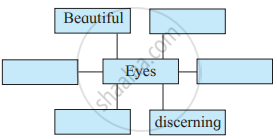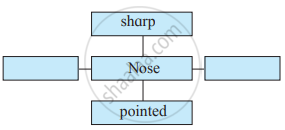Advertisements
Advertisements
प्रश्न
Answer any four of the following questions in 30 - 40 words each :
(a) What kind of gold did the people of Seemapuri look for in the garbage ? (Lost Spring)
(b) Why did Gandhi tell the court that he was involved in a 'conflict of duties' ?
(c) How do we get joy from life which is otherwise full of sorrows ? (A Thing of Beauty)
(d) For Aunt Jennifer, what do the tigers symbolise ?
(e) What made the chief astrologer place his finger on his nose ? (The Tiger King)
(f) On the seventh day after the American soldier was found by Dr. Sadao two things happened. Why did Hana feel scared of the second ?
उत्तर
a) To the people of Seemapuri, garbage was gold. Their rooting through the garbage would occasionally turn up a rupee, even a ten-rupee note and that would give them the hope to continue scrounging for more.
b) Gandhi told the court that he was involved in a conflict of duties because on one hand, he was obliged not to set a bad example as a lawbreaker and on the other hand, it was important for him to render humanitarian and national service for which he had come.
c) A thing of beauty brings a peaceful splendour into our lives and disperses the gloom that is a constant companion of our mortality. It brightens gloomy days and the unhealthy, darkened recesses of our minds. It removes the pall that our dark spirits cast upon us by the lightness of its beauty.
d) The bold images of the tigers are contrasted with the timidity of the woman, Aunt Jennifer, who creates them. They are fearless and assertive, unlike their creator who leads an ordered and conventional life under the shadow of her husband. The tigers are symbolic of her wish for a free rein to her womanhood, independent of her role as someone’s wife.
e) The chief astrologer had placed his finger on his nose in wonder. He was astonished at the remarkable feat of a barely ten days old baby who had opened its lips in speech and raised intelligent questions.
f) The second thing that happened on the seventh day was the arrival of a messenger at their door in official uniform. This frightened Hana because she feared that the servants might have told the authorities about the couple hiding an enemy soldier.
APPEARS IN
संबंधित प्रश्न
Describe Miss Stapleton's first encounter with Sir Henry in about 125 words
Notice these expression in the text. Infer their meaning from the context.
salt flats
Discuss the following statement in groups of two pairs, each pair in a group taking opposite points of view.
The methods of inquiry of history, science, and philosophy are similar.
We 'draw up a deed'. Complete the following phrase with an appropriate word.
________ends meet
How does Forster trace the human interest in the story to primitive times?
Personification is a figure of speech that attributes human qualities to inanimate things and abstract ideas. How has it been used in the poem?
Study the pictures below and note down the differences.


Life is an amalgam of happy and sad moments. Think of such moments in your life, pair with your classmate, and share both the aspects of life.
| Happy Moments | Sad Moments |
| 1. Winning the first prize in a competition | Losing your mobile, bicycle, or wallet |
| 2. | |
| 3. |
The poem is a Petrarchan Sonnet. The poem is divided into two parts -
- An Octave
The first part comprising eight lines. - A sestet
The second part comprising six lines.
Read the first four lines of the poem. The rhyme scheme is a b b a. Read the rhyme scheme for the next four lines. It is a b b a. Now read the first three lines of the sestet and note the rhyme scheme. It is c d c. The rhyme scheme of the last three lines is d c d. This is the common design of a Petrarchan Sonnet.
This is a Petrarchan Sonnet. Complete the given table by giving examples from the poem.
| Features | Examples / Lines |
| Objects used | |
| Praise/blames | |
| Metaphor | |
| Simile | |
| Personification | |
| Number of lines | |
| Rhyme scheme |
Complete the web with the help of adjectives used to describe eyes and nose in all respects. Two are done for you.


Find out from a vet or from a website, what precaution a vet has to take when he/she is called to treat wild, dangerous animals?
Make point-wise notes of the same.
Answer the following question in short.
What do you learn about Pundits of Vijaynagar?
Correct the given sentence with justification.
Since there is a reference to the Indian boy, there are some scenes from India too.
Have you seen how wheels move on different surfaces like sand, gravel, grass, or a proper road? What are the differences you see?
Shylock demanded a pound of Antonio’s flesh.
Who is the speaker in the poem?
Complete the following sentence with reference to the passage:
The king was determined to prevent his beloved son from ____________.
What characteristics of Mr. Nobody do we learn about from this poem?
Gather more information about cold winters in Russia.
How did the middle brother use rice?
What are the skills/values a teacher should teach their students to live in this competitive world?
The farmer had _______ daughters.
Akilan learnt Judo for ______.
Answer the following yes or no question.
Did all visit the waterfall?
Choose the correct answer.

Circle and write the adverbs.
I'm waiting here. ______
What did the children buy with money they have?
Name the things that good merchant offered for the plate
What did the boy make with the branches of the tree?
On the basis of your understanding of the given passage, make notes in any appropriate format.
The Sherpas were nomadic people who first migrated from Tibet approximately 600 years ago, through the Nangpa La pass and settled in the Solukhumbu District, Nepal. These nomadic people then gradually moved westward along salt trade routes. During 14th century, Sherpa ancestors migrated from Kham. The group of people from the Kham region, east of Tibet, was called “Shyar Khamba”. The inhabitants of Shyar Khamba, were called Sherpa. Sherpa migrants travelled through Ü and Tsang, before crossing the Himalayas. According to Sherpa oral history, four groups migrated out of Solukhumbu at different times, giving rise to the four fundamental Sherpa clans: Minyagpa, Thimmi, Sertawa and Chawa. These four groups have since split into the more than 20 different clans that exist today
Sherpas had little contact with the world beyond the mountains and they spoke their own language. AngDawa, a 76-year-old former mountaineer recalled “My first expedition was to Makalu [the world’s fifth highest mountain] with Sir Edmund Hillary’’. We were not allowed to go to the top. We wore leather boots that got really heavy when wet, and we only got a little salary, but we danced the Sherpa dance, and we were able to buy firewood and make campfires, and we spent a lot of the time dancing and singing and drinking. Today Sherpas get good pay and good equipment, but they don’t have good entertainment. My one regret is that I never got to the top of Everest. I got to the South Summit, but I never got a chance to go for the top.
The transformation began when the Sherpa Tenzing Norgay and the New Zealander Edmund Hillary scaled Everest in 1953. Edmund Hillary took efforts to build schools and health clinics to raise the living standards of the Sherpas. Thus life in Khumbu improved due to the efforts taken by Edmund Hillary and hence he was known as ‘Sherpa King’.
Sherpas working on the Everest generally tend to perish one by one, casualties of crevasse falls, avalanches, and altitude sickness. Some have simply disappeared on the mountain, never to be seen again. Apart from the bad seasons in 1922, 1970 and 2014 they do not die en masse. Sherpas carry the heaviest loads and pay the highest prices on the world’s tallest mountain. In some ways, Sherpas have benefited from the commercialization of the Everest more than any group, earning income from thousands of climbers and trekkers drawn to the mountain. While interest in climbing Everest grew gradually over the decades after the first ascent, it wasn’t until the 1990s that the economic motives of commercial guiding on Everest began. This leads to eclipse the amateur impetus of traditional mountaineering. Climbers looked after each other for the love of adventure and “the brotherhood of the rope” now are tending to mountain businesses. Sherpas have taken up jobs as guides to look after clients for a salary. Commercial guiding agencies promised any reasonably fit person a shot at Everest.
